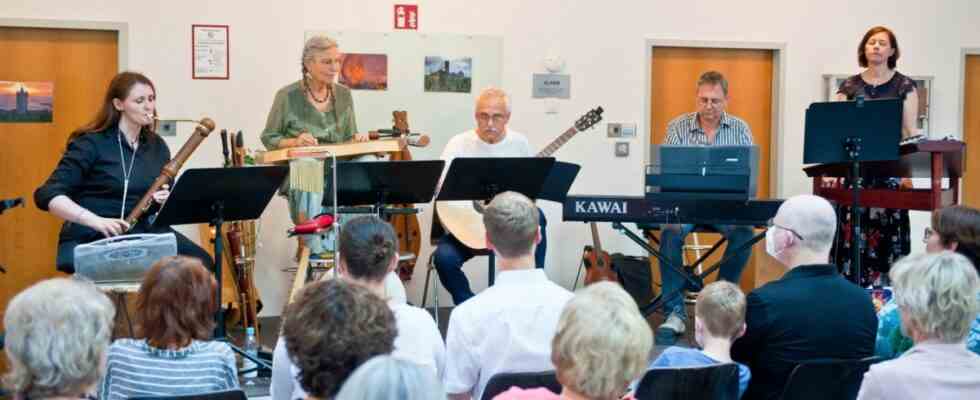How did folk music come into the world? People who left or had to leave their homes with little or nothing to take with them kept two things in their hearts and minds: their language and their music. Because where words and sentences in a new world initially failed because others could not understand them, making music together remained in order to communicate. Especially since one’s own voice was already present on instruments and additional equipment was easy to produce. A drum kit made of two spoons, a hand-carved flute, a drum box, a metallophone made of scrap tin, a horn made of hose and pipes, a few nails hammered into wood with wire stretched between them as a plucking board. Anyone who takes a close look at the instrumental portfolio of the band “Dulcimore” and then also devotes their ears to it, will find many allusions to this traditional “traveling house music”, which over the years and decades has returned across the oceans to Zorneding. There, in the town hall, the five-strong ensemble gave a much-acclaimed comeback on Saturday evening after two years of forced abstinence, during which they showed in more than two extremely lively hours that they had neither forgotten their craft nor lost their fun in the joy.
When selecting their titles, the lion’s share of them in their own arrangements, the five prove time and time again that their multi-instrumentality is neither an end in itself nor pure hobby, but is selected and composed cleverly and differentiated according to melody and message. As early as the third number in the first set, Scott Joplin’s “The Entertainer”, the cast of piano, guitar, tenor flute, bass flute and dulcimer moves the title into the intermediate world of Chicago’s streets and the Bavarian foothills of the Alps, supplemented by small excursions into the classical, for example in Bach’s “Sleepers Awake”. In this form, the piece then also fits into the sound of the traditional Hoagascht form, which one feels reminded of several times that evening, whereby the quintet repeatedly plays along with itself as a new guest in the flying change of instruments and vocal parts, picks up melodies and varies them.
It takes a strong understanding of music, lots of rehearsals and a very good understanding of each other if – as has happened – this motley world of sound is to appear random and reliable at the same time. Betty Baindl, Brigitte Fritsch, Sigrid Koska, Peter Benz and Axel Obermeier succeed in weaving in modern instruments elegantly and fluently; the electronic piano anyway, but also the “Ewi”, short for “Electric Wind Instrument”, a kind of blowable synthesizer that allows the saxophone sound to be easily imitated in particular. You learn amazing new things and look forward to a stimulating demonstration of technical innovation. All the greater is the pleasure of listening, which breaks through the loud applause of the probably oldest listener in the audience with the bell on the rollator.
What also contributes significantly to this enjoyment: The program sheet not only reveals the year and authorship of the respective title, but also tells little stories about its content. Such a brisk tempo and sung English opens an additional door to understanding. “A pretty but very shy suspected Spaniard (???) in Dublin always takes flight when the lover in love approaches,” it says, for example, about “The Spanish Lady”, which guitarist Peter Benz arranged extremely cleverly. Just like the desire for one’s own note and the ability to create witty combinations run like red threads through the program and produce some combinations that are as surprising as they are inspiring – such as the amazing combination of Grieg’s “In the Great Hall of the Mountain King” with the shanty “Soon may the Wellmen come”. Over the course of the two hours, each and every one of the ensemble gives convincing testimony of their respective compositional skills.
The atrium of Zorneding’s town hall, meanwhile, seems extremely sterile for the emotionally charged music of “Dulcimore”. Although one has to acknowledge that there are (and still are) venues that are open to concerts. But what is missing to complete the atmosphere are the wooden planks underfoot, which creak along with the rhythm or amplify the instruments in the dance, are the dim lanterns of a speakeasy, which are outshined by the glittering joy of the musicians, are the background noise of clinking glasses and rattling dishes. Marble, concrete and LED lamps simply cannot keep up. Although, to the delight of the ears, the open hatches in the glass roof let in the singing of the birds, which cheerfully and carelessly extend the after-effects of the last bar again and again.
At the end of the acclaimed concert there was a farewell: Sigrid Kostka, the master of plucked instruments, wants to devote herself exclusively to playing the harp in the future – a decision matured in pandemic abstinence. As a result, “Dulcimore” temporarily becomes “Dulicless”, because with it the eponymous instrument also leaves the band. However, it is strongly to be assumed that with the improvisational talent of the folk forefathers and the attraction of the band, which was irresistible on Saturday despite the heat and strong competition, something new will find its way into the old and the desire for an “encore” will not end in two titles, but in a new concert.

